In many organizations, moving away from a culture of punishment when mistakes are made is a significant leap forward. It signals a shift toward understanding, systems thinking, and improvement.
But once you've made that change, what's next? Do we need to replace punitive approaches with something better? If so, what? How do you ensure that your new approach leads to meaningful learning and continuous improvement?
The First Step: Moving Away from Punishment
For far too long, punitive approaches to mistakes have been the norm in many workplaces. This approach is rooted in the belief that fear of punishment will prevent mistakes.
However, as I discuss in The Mistakes That Make Us, fear actually causes more harm than good. When people are afraid to speak up, errors are hidden, and systemic problems remain unsolved. This kind of culture doesn't just stifle innovation–it also creates an environment where employees feel disengaged and undervalued.
When you stop punishing people for mistakes, it's a crucial first step. But it's not enough on its own. The question then becomes: What should we do next to foster a culture that truly embraces learning and improvement?
The Pitfalls of Being “Nice”
After abandoning punitive measures, the next instinct might be to simply be “nice” about mistakes. This often means downplaying errors or offering gentle reassurances without much follow-up.
Nice is about not wanting to make another person feel bad.
While being nice is certainly an improvement over being punitive, it doesn't necessarily lead to the deep, continuous learning organizations need.
In The Mistakes That Make Us, I share that being “nice” can sometimes be a way to avoid difficult conversations. However, avoiding these conversations means missing out on opportunities to learn and grow. If mistakes are glossed over or treated too lightly, the underlying causes remain unaddressed, allowing problems to persist.
So, if being nice isn't the answer, what is?
And I give all the credit in the world to my friend Karyn Ross for helping me understand this…
The Next Step: Embracing Kindness
The real solution is moving from being “nice” to being “kind.”
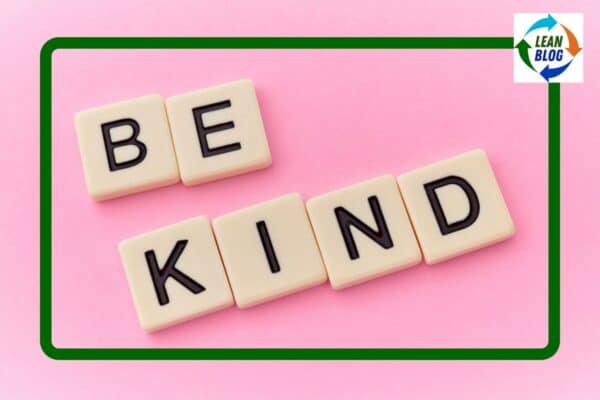
Kindness, in this context, is about addressing mistakes with empathy and a commitment to improvement. It's about having open, honest discussions that focus on learning and preventing future errors, rather than just smoothing things over.
If nice is about not making others feel bad, kind is about being helpful and constructive.
As I wrote in The Mistakes That Make Us:
“The most important lesson might be that the right culture is one where people are comfortable admitting mistakes, because they know they'll be treated with kindness instead of blame.”
This quote highlights the essence of what it means to be kind in the workplace–cultivating an environment where people can feel safe discussing mistakes openly and constructively.
Kindness doesn't mean avoiding tough conversations. It means approaching them with a mindset that values learning over blame. In a kind culture, mistakes are seen as opportunities to gather valuable insights and improve systems. This approach fosters trust, collaboration, and a genuine commitment to continuous improvement.
Check out my podcast with Karyn on her book The Kind Leader.
Survey Results
When speaking about these topics, I like to do “live polling” of the audience using a tool called Mentimeter.
At a recent Lean conference, I asked one group of attendees from different organizations and industries to say what the most likely response to mistakes was in their organization. This distribution is very typical of other mixed groups that I've surveyed:
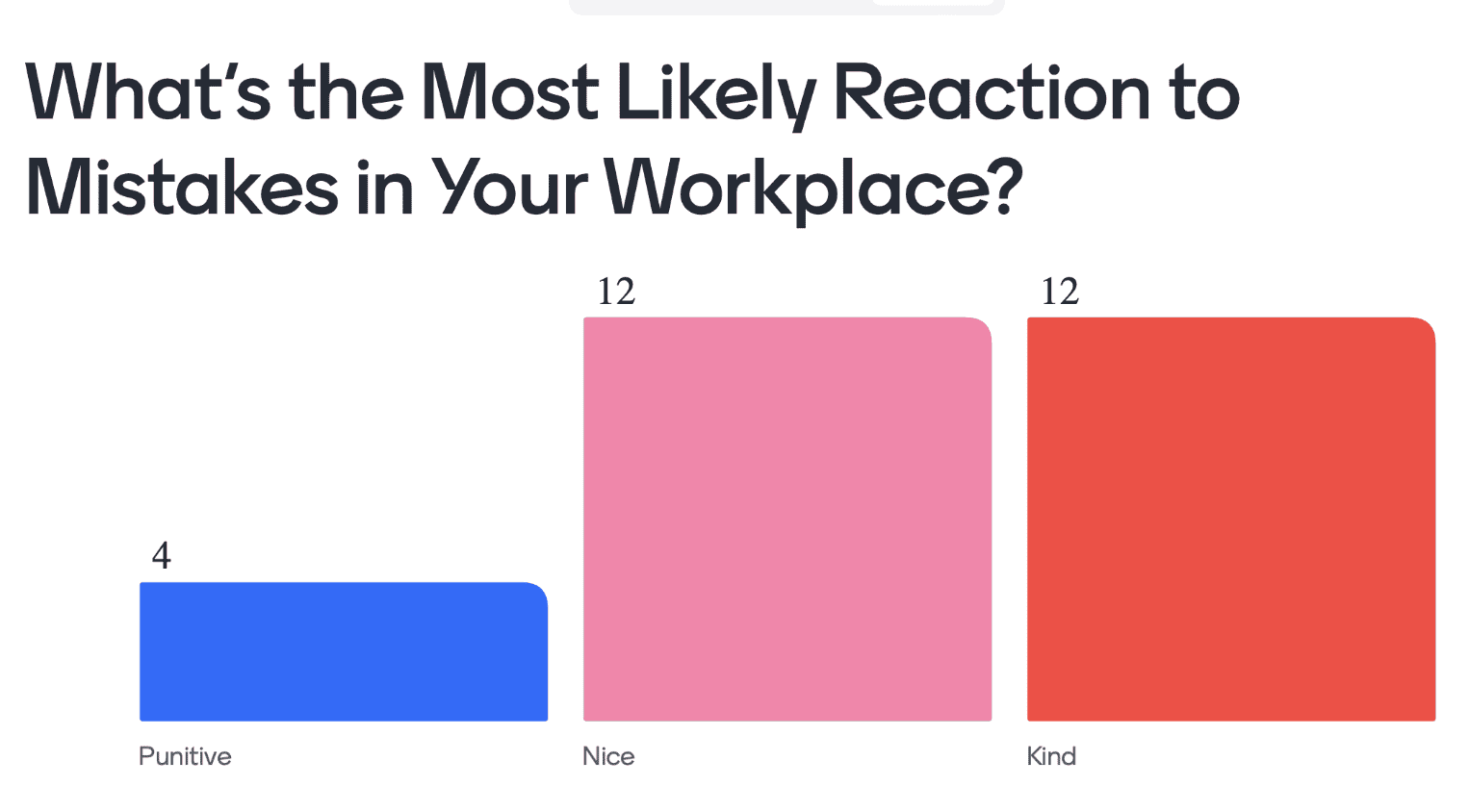
Thankfully, there weren't too many punitive responses (although it's sad and unfortunate to see any).
Another event I surveyed had a bell curve distribution, showing a need to shift from nice to kind:
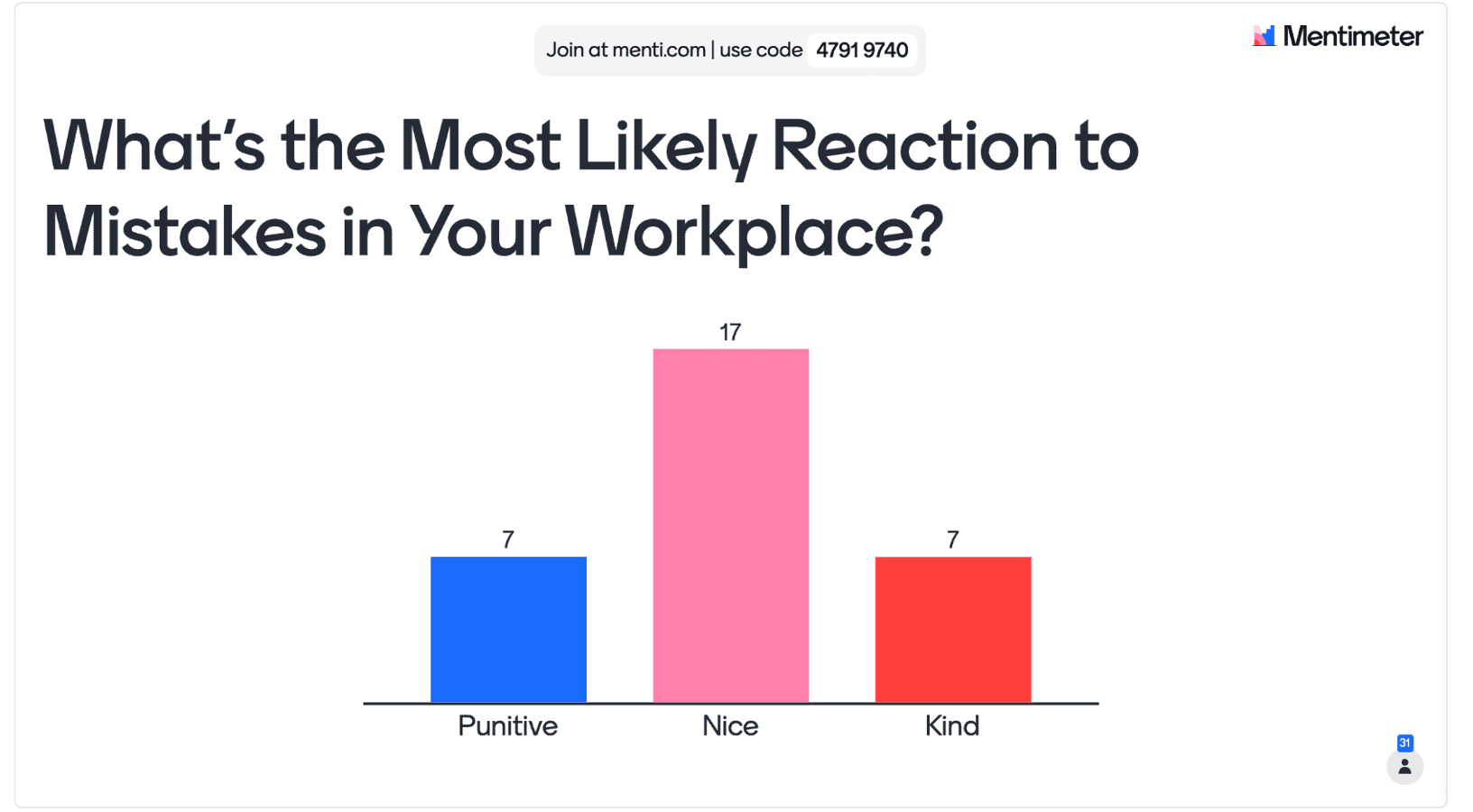
When I asked the team at KaiNexus to answer this same question, it's the only time I've seen ZERO punitive votes. There was some glitch where the voting was spread across two identical polls:
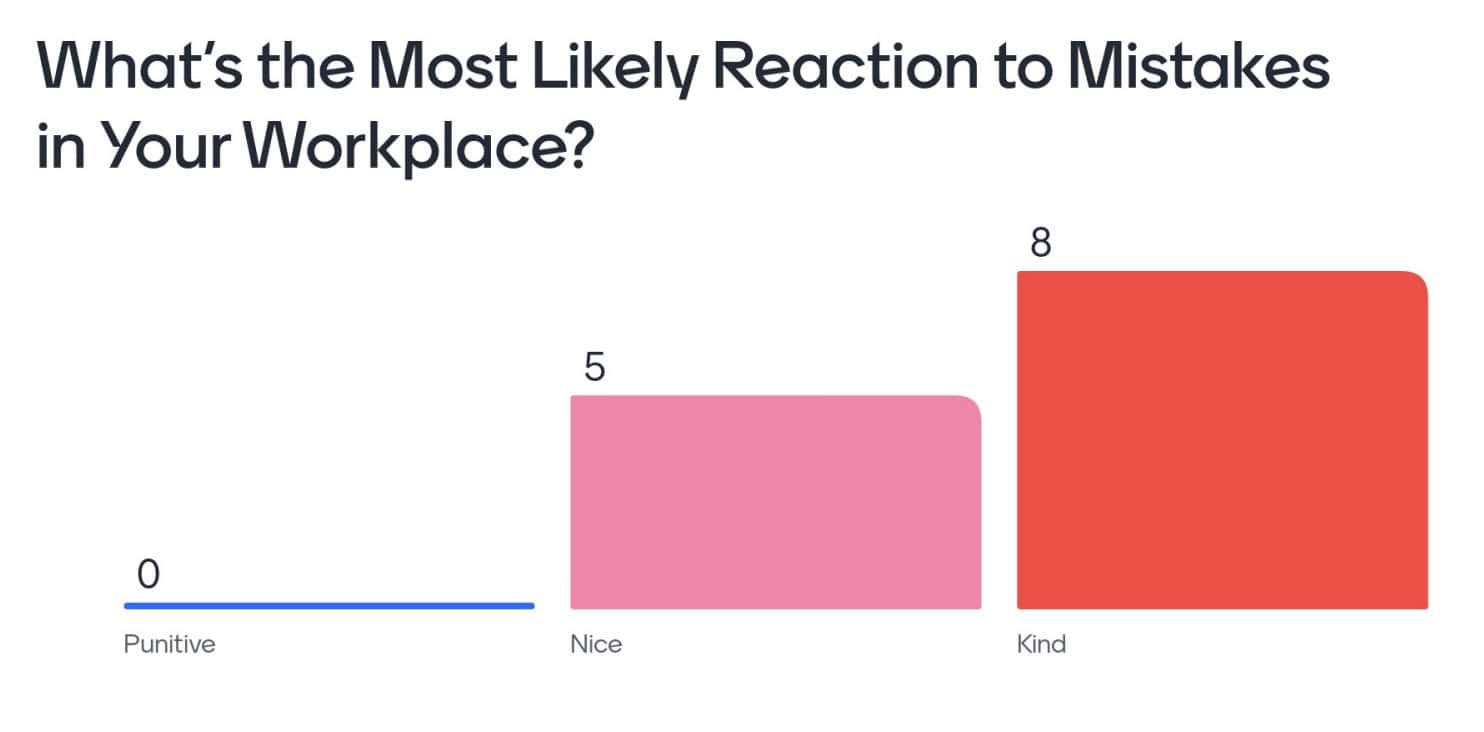
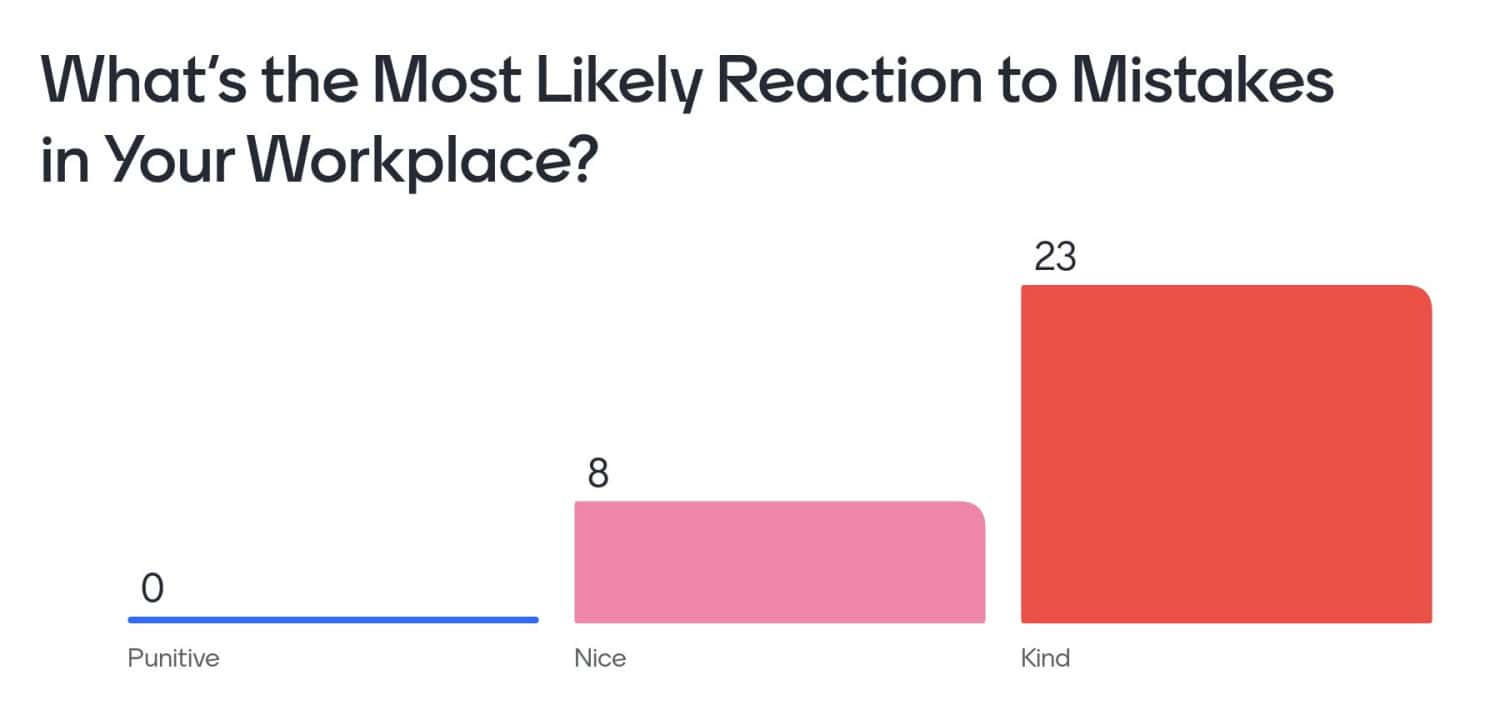
But the total responses were:
- Punitive: 0
- Nice: 13
- Kind: 31
This was anonymous polling. And I don't think people would have felt pressured to give the responses they thought management wanted to see. When we've done broader psychological safety surveys in the past, KaiNexus scored, as a whole, at the 80th percentile, so there's a good culture in place (but admittedly not perfect).
How to Cultivate a Kind Culture
Now that you've moved away from punishment and understand the importance of kindness over niceness, how do you cultivate this in your organization? Here are some practical steps:
- Encourage Open Communication: Make it clear that mistakes are opportunities for learning, not grounds for blame. Foster an environment where employees feel safe to speak up about errors.
- Practice Constructive Feedback: When addressing mistakes, focus on the process, not the person. Ask, “What can we learn from this?” and “How can we improve our systems to prevent this in the future?”
- Lead by Example: Leaders should model the kind behaviors they want to see. This includes being kind to yourself. Show kindness in your responses to mistakes, reinforcing that continuous improvement is a shared responsibility.
- Foster Collaboration: Encourage teams to work together to solve problems. Collaborative problem-solving leads to better solutions and a stronger sense of shared purpose.
- Celebrate Learning: When a mistake leads to positive change, celebrate that outcome. Recognize the team's effort to learn and grow, reinforcing the value of a kind approach to mistakes.
Conclusion: Moving Forward with Kindness
So, you've stopped punishing people for mistakes. The next step is to ensure that you're not just being nice, but truly kind.
Kindness in the workplace involves addressing mistakes in a way that promotes learning and improvement. It's about creating a culture where people feel safe to admit errors and are motivated to collaborate on solutions.
As I emphasize in The Mistakes That Make Us, shifting from a punitive culture to one rooted in kindness can transform your organization. It leads to more engaged, empowered, and satisfied employees who are committed to continuous improvement.
Now that you've stopped punishing mistakes, what's next? Lead with kindness, and watch your organization–and your people–thrive.
What do you think? Please scroll down (or click) to post a comment. Or please share the post with your thoughts on LinkedIn – and follow me or connect with me there.
Did you like this post? Make sure you don't miss a post or podcast — Subscribe to get notified about posts via email daily or weekly.
Check out my latest book, The Mistakes That Make Us: Cultivating a Culture of Learning and Innovation:










Mark: Love to see the cross pollination between you and Karyn.
As I read your suggestions about practical steps to encourage kind workplaces, it occurred to me that “encourage open communication” is really what the other four steps do. I cannot “do” “encourage open communication”. What a leader can do is “respond to mistakes with curiosity to discover what can be learned.” That’s something practical. That is behaviour I can look for as an observer, or behaviour I can copy if I report to the person behaving that way.
In general, I think the practical “what can I do” is in the explanations more than in the headers.
As for “practice constructive feedback”, what if it were written, “deliver feedback – good and bad – frequently and in a neutral tone, using curiosity to uncover what it was in the system (the operating pattern) that contributed to the observed performance
Hugh – Thanks for reading and thanks for taking the time to comment.
I like the way you stated this: “deliver feedback – good and bad – frequently and in a neutral tone, using curiosity to uncover what it was in the system (the operating pattern) that contributed to the observed performance”